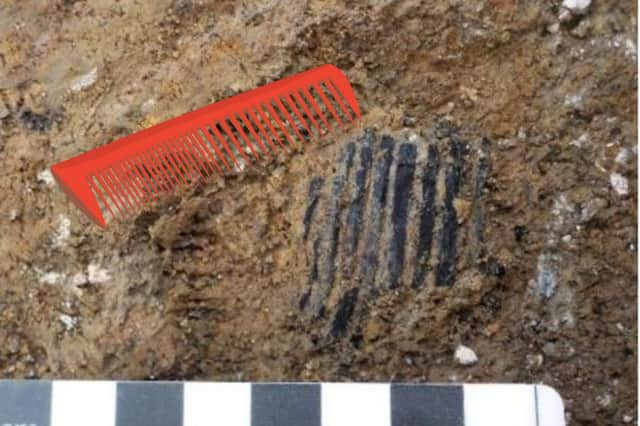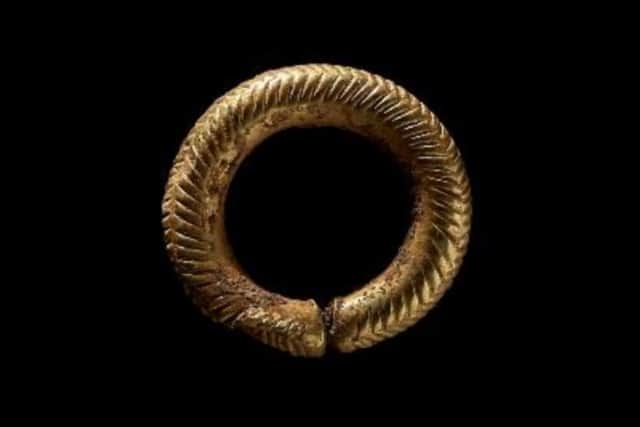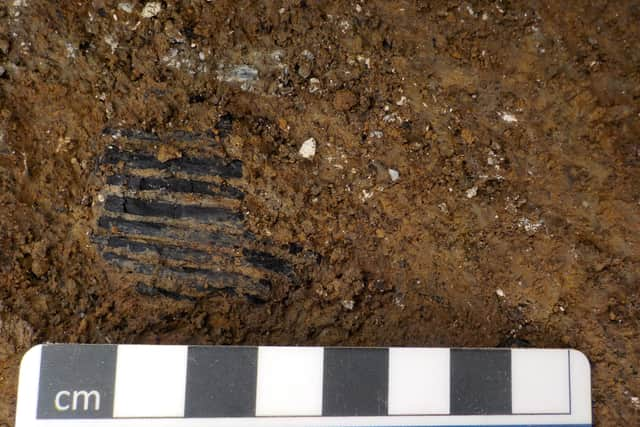What is the history of the hair comb after 'unparalled' 3,000-year-old discovery is made in Wales?


Archaeologists in Wales discovered what they believe is the oldest comb ever found in the UK. It seems the experts involved found more than they expected as they excavated a road scheme in south Wales.
The work - carried out on behalf of the Vale of Glamorgan Council and the Welsh Government found a wooden comb that is more than 3,000 years old and dates to the Bronze Age.
Advertisement
Hide AdAdvertisement
Hide AdBelieved to have been burned as part of a cremation ceremony at the time, a gold hair ring was also found at the site - playing up the suggested importance of public appearance (such as hairstyles - during that time in the Vale of Glamorgan.
Adam Gwilt, Principal Curator for Prehistory at Amgueddfa Cymru – Museum Wales said: “This cremation burial, with its accompanying gold ring and wooden comb, gives us a glimpse of life and death in Bronze Age times.
"The gold ring is a very early, well-made and small example of its type, offering new insight into the development of hair-rings as a form of early jewellery across Britain and Ireland.


"This grave is just one example of a much wider wealth of prehistoric burial evidences now being discovered across the Vale of Glamorgan, indicating the richness, diversity and significance of this archaeology and informing our wider understanding of the past.”
Advertisement
Hide AdAdvertisement
Hide AdBut the find raises another more important question of how far back the comb itself dates in human history as a self-grooming tool.
This is something that some extensive research has been carried out on previously - namely by academics at the University of Oxford's Pitt Rivers Museum.
Researchers here suggest that while the comb found in Wales is 3,000 years old, the invention of the comb could date back as far as 8,000 years ago.


A statement on its website reads: "Combs have been used to both tame and decorate the hair for centuries. The basic design evolved from the fingers of the human hand. The earliest known comb, made from animal bone and found in Syria, is said to date from 8000 BC and is fundamentally the same form as the mass-produced plastic comb of today.
Advertisement
Hide AdAdvertisement
Hide Ad"From Bronze-Age man to Cleopatra, to Napoleon's wife, Josephine, all would recognize these items as such."
Other estimates place the comb's invention at around 5,500 years ago.
Now, Museum Wales is working to acquire the two artefacts found at the site following its independent valuation by the Treasure Value Committee.
Excavations dating back to 2017 and 2018 at Five Mile Lane, an area just outside Barry in south Wales, uncovered an unknown multi-period landscape that was used in a multitude of ways since humans first settled in the Vale of Glamorgan.
Advertisement
Hide AdAdvertisement
Hide AdDavid Gilbert, Project Manager for Red River Archaeology Group said: “The gold ring is obviously the most eye-catching object to accompany the cremation. However, the most important artefact is what may at first glance seem the more mundane: the wooden comb, which is a find without parallel in Wales, if not the UK.
"Together, these lend the human element to our work, highlighting the importance of these objects to the person buried with them. Showing the attention to detail and pride in appearance missing from so many depictions of prehistoric people on television or in films."
Comment Guidelines
National World encourages reader discussion on our stories. User feedback, insights and back-and-forth exchanges add a rich layer of context to reporting. Please review our Community Guidelines before commenting.
